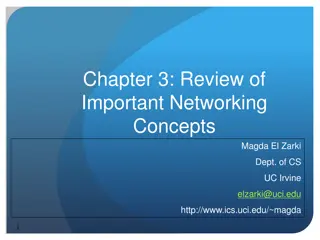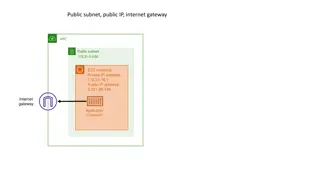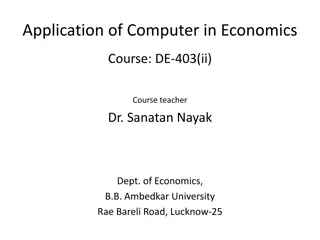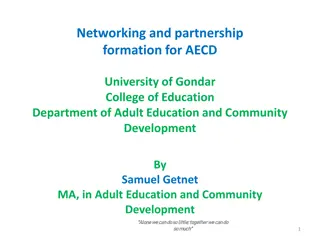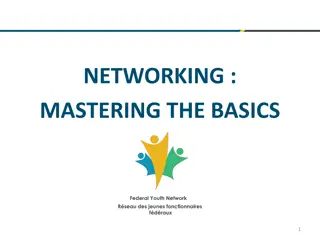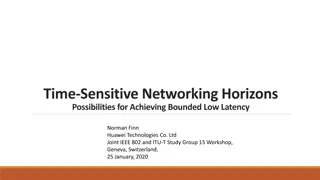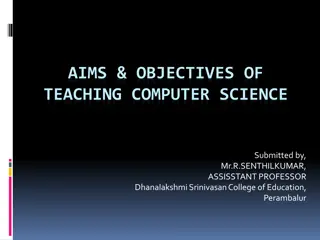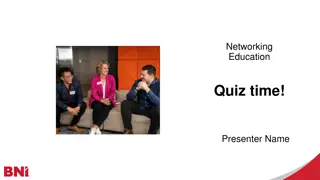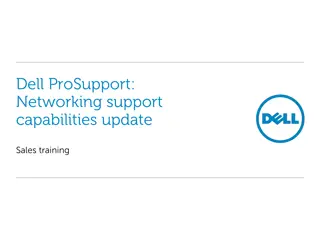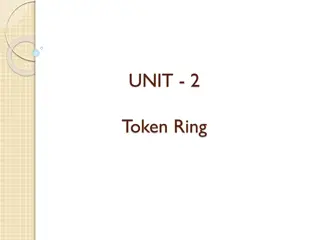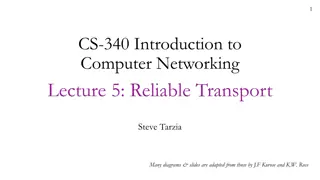Evolution of Computer Networking
In the early days, direct computer communication was non-existent. Researchers in the late 1960s pioneered the concept of computer networks by enabling computers to transmit data packets. This led to the development of interconnected networks, ultimately forming the Internet. Learn about internet protocols, DNS, TCP, and the client-server model.
Download Presentation

Please find below an Image/Link to download the presentation.
The content on the website is provided AS IS for your information and personal use only. It may not be sold, licensed, or shared on other websites without obtaining consent from the author.If you encounter any issues during the download, it is possible that the publisher has removed the file from their server.
You are allowed to download the files provided on this website for personal or commercial use, subject to the condition that they are used lawfully. All files are the property of their respective owners.
The content on the website is provided AS IS for your information and personal use only. It may not be sold, licensed, or shared on other websites without obtaining consent from the author.
E N D
Presentation Transcript
CS18000: Problem Solving and Object-Oriented Programming Network I/O (revised 3/18/24)
Communication Among Computers In the early days, computers had no way to communicate directly with each other If you had information on computer A that you needed on computer B, you had to write a file onto a device that could be transported from computer A to be read on computer B In the late 1960s some researchers in universities, industry, and the military started working on a way to have computers directly communicate with each other The idea was a wire that would allow packets of bits to be transmitted from computer A to computer B This would be replaced with wireless means of sending information 2
Computer Networks Computers in one building could all have a pathway to send information to any other computer in that building -- a network The networks in two different buildings could be connected so that computers in one building could send information to computers in other buildings -- a network of networks Eventually resulted in worldwide Interconnected Computer Networks -- the Internet One of the pioneers whose research work helped in the development of the Internet is Purdue Computer Science Professor Douglas Comer 3
Some (Simplified) Definitions Internet Protocol (IP): Identifies hosts (servers, workstations, laptops, etc.) with a unique address (e.g., 128.10.2.21) Domain Name System (DNS): Maps domain names (e.g., galahad.cs.purdue.edu) to IP addresses (e.g., 128.10.9.143) Transmission Control Protocol (TCP): Identifies ports on hosts for a network connection Socket: IP address plus TCP port Two sockets makes a network connection 4
Client-Server A Server is a process that waits for a connection A Client is a process that connects to a server At different times, a process may be both a client and a server Need not be associated with a specific computer: Any computer can have both client and server processes running on it Once connected, the client and server can both read and write data to one another asynchronously ( a bi-directional byte pipe ) 5
Use of Sockets Clients and Servers communicate via Sockets Socket: IP address plus TCP port Think: street name plus house number IP addresses Identifies a computer on the Internet Public addresses are globally unique Represented using dotted-decimal (byte) notation: 128.10.9.143 Some firewalls translate addresses to internal ones (e.g., PAL) Port number 0-65535 (16 bits) Low-valued port numbers are reserved for privileged processes 6
Objects and Networking in Java You know that Java objects can be written to and read from files Java objects can also be exchanged over network connections Uses ObjectOutputStream and ObjectInputStream Tricky bits ObjectOutputStream generates a header of information that must be read Requires flush to ensure ObjectInputStream reader is not blocked Blocking (or being blocked) means that code is prevented from running or data is prevented from moving from one computer to another. 7
ObjectStream Client-Server Timeline Client Process Server Process Server starts: opens ServerSocket and blocks (waiting for client) Client starts: opens Socket to Server Server receives connection Server opens ObjectOutputStream, sends header with flush Client opens ObjectOutputStream, sends header with flush Server receives object stream header Client receives object stream header Client and Server exchange objects in agreed upon order 8
Java Networking Class: Socket Models a TCP/IP socket Used by Client to identify Server IP address (or DNS name) Port number new Socket("pc.cs.purdue.edu", 12190) Used by Server to identify connected Client Provides streams for communications: getOutputStream() getInputStream() 9
Java Networking Class: ServerSocket Used by Server to wait for a Client to connect Constructor specifies TCP port number to use: ServerSocket ss = new ServerSocket(4242); Method accept() blocks waiting for connection Socket socket = ss.accept(); 10
Video 2 Clients and Servers
Example: Object Server import java.io.*; import java.net.*; public class Server { public static void main(String[] args) throws IOException, ClassNotFoundException { // create socket on agreed-upon port... ServerSocket serverSocket = new ServerSocket(4242); // wait for client to connect, get socket connection... Socket socket = serverSocket.accept(); // open output stream to client, flush send header, then input stream... ObjectOutputStream oos = new ObjectOutputStream(socket.getOutputStream()); oos.flush(); // ensure data is sent to the client ObjectInputStream ois = new ObjectInputStream(socket.getInputStream()); // send object(s) to client... String s1 = "hello there"; oos.writeObject(s1); oos.flush(); // ensure data is sent to the client System.out.printf("sent to client: %s\n", s1); // read object(s) from client... String s2 = (String) ois.readObject(); System.out.printf("received from client: %s\n", s2); // close streams... oos.close(); ois.close(); } } 12
Example: Object Client import java.io.*; import java.net.*; public class Client { public static void main(String[] args) throws UnknownHostException, IOException, ClassNotFoundException { // create socket on agreed upon port (and local host for this example)... Socket socket = new Socket("data.cs.purdue.edu", 4242); // open input stream first, gets header from server... ObjectInputStream ois = new ObjectInputStream(socket.getInputStream()); // open output stream second, send header to server... ObjectOutputStream oos = new ObjectOutputStream(socket.getOutputStream()); oos.flush(); // ensure data is sent to the server // read object(s) from server... String s1 = (String) ois.readObject(); System.out.printf("received from server: %s\n", s1); // write object(s) to server... String s2 = s1.toUpperCase(); oos.writeObject(s2); oos.flush(); // ensure data is sent to the server System.out.printf("sent to server: %s\n", s2); // close streams... oos.close(); ois.close(); } } 13
Client-Server with Threads In many (most?) cases, a single server is connected to by multiple clients Server must be able to communicate with all clients simultaneously no blocking Technique: server creates a separate thread to handle each client as it connects Client and server may also each create separate thread for reading and writing 14
Example: Echo Server Simple server that accepts connections from multiple clients Spawns a thread for each client Reads lines from the connection, logs information, echoes lines back Useful for debugging network and code 15
Echo Server Timeline Client Process Server Process Server starts: opens ServerSocket and blocks (waiting for client) Client 1 starts: opens Socket to Server Server receives connection Client 2 starts: opens Socket to Server Server creates thread Client 1 sends line Client 3 starts: opens Socket to Server Server thread 1 reads/echoes line Client 1 reads line 16
Example: Echo Server (1) import java.io.IOException; import java.io.PrintWriter; import java.net.ServerSocket; import java.net.Socket; import java.util.Scanner; public class EchoServer implements Runnable { Socket socket; public EchoServer(Socket socket) { this.socket = socket; } // continued 17
Example: Echo Server (2) // run method for thread... public void run() { System.out.printf("connection received from %s\n", socket); try { // socket open: make PrinterWriter and Scanner from it... PrintWriter pw = new PrintWriter(socket.getOutputStream()); Scanner in = new Scanner(socket.getInputStream()); // read from input, log client request, echo client input... while (in.hasNextLine()) { String line = in.nextLine(); System.out.printf("%s says: %s\n", socket, line); pw.printf("echo: %s\n", line); pw.flush(); } // input done, close connections... pw.close(); in.close(); } catch (IOException e) { e.printStackTrace(); } } 18
Example: Echo Server (3) // main method... public static void main(String[] args) throws IOException { // allocate server socket at given port... ServerSocket serverSocket = new ServerSocket(4343); System.out.printf("socket open, waiting for connections on %s\n", serverSocket); // infinite server loop: accept connection, // spawn thread to handle... while (true) { Socket socket = serverSocket.accept(); EchoServer server = new EchoServer(socket); new Thread(server).start(); } } } 19
Network Communication in Java Uses standard file I/O classes: low-level, high- level, object, and text Adds abstractions to deal with network connections ServerSocket to wait for connections Socket abstracts a TCP socket (IP address + port) Uses threads to improve responsiveness and avoid blocking 20







